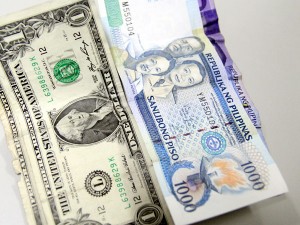Peso closes at 44.80:$1, weakest in over 3 years

The peso on Tuesday fell to its weakest against the US dollar in over three years due to global economic uncertainties and inflationary threats in the Philippines. Photo by INQUIRER.net
The peso on Tuesday fell to its weakest against the US dollar in over three years due to global economic uncertainties and inflationary threats in the Philippines.
The local currency closed at 44.80:$1 on Tuesday, its weakest since September 2010. The latest close was also down by 10 centavos from the previous day’s finish of 44.70:$1.
Intraday high hit 44.66:$1, while intraday low was at 44.851:$1. The volume of trade amounted to $903.6 million from the previous $1.123 billion.
The peso weakened following the release of a report showing HSBC’s estimate that China’s services sector slowed down in December, with the purchasing managers’ index (PMI) dropping to 50.9 from 52.5 the previous month.
The report coincided with fears that China would see this year a significant slowdown in economic activity, which would dampen economic growth of exporting countries, including the Philippines.
Article continues after this advertisementOn the domestic front, the Philippines’ National Statistics Office (NSO) released a report showing that the annual inflation rate in the country accelerated to 4.1 percent in December 2013, the fastest in nearly two years.
Article continues after this advertisementThis was due to such factors as supply disruption due to the recent supertyphoon, hike in power rates and increase in fuel prices.
The Bangko Sentral ng Pilipinas said the December inflation signaled the likely trend of inflation for 2014, when consumer prices are seen to increase by a much faster rate than last year’s.
The BSP said inflation could average in the 4-percent territory this year compared with the average of 3 percent last year.
BSP Governor Amando Tetangco Jr., however, stressed that a 4-percent inflation was still within the official target of 3 to 5 percent.
Tetangco added that a 4-percent inflation could still be considered modest and would not have an adverse effect on economic growth.
The Philippine government wants the economy to grow by between 6.5 and 7.5 percent this year to help bring down the country’s level of poverty.
Economic officials earlier said the Philippines was still poised to meet its economic growth target despite challenges posed by uncertainties in the global economy.
They said domestic demand would still be robust, supported by remittances and rising investments by local firms.